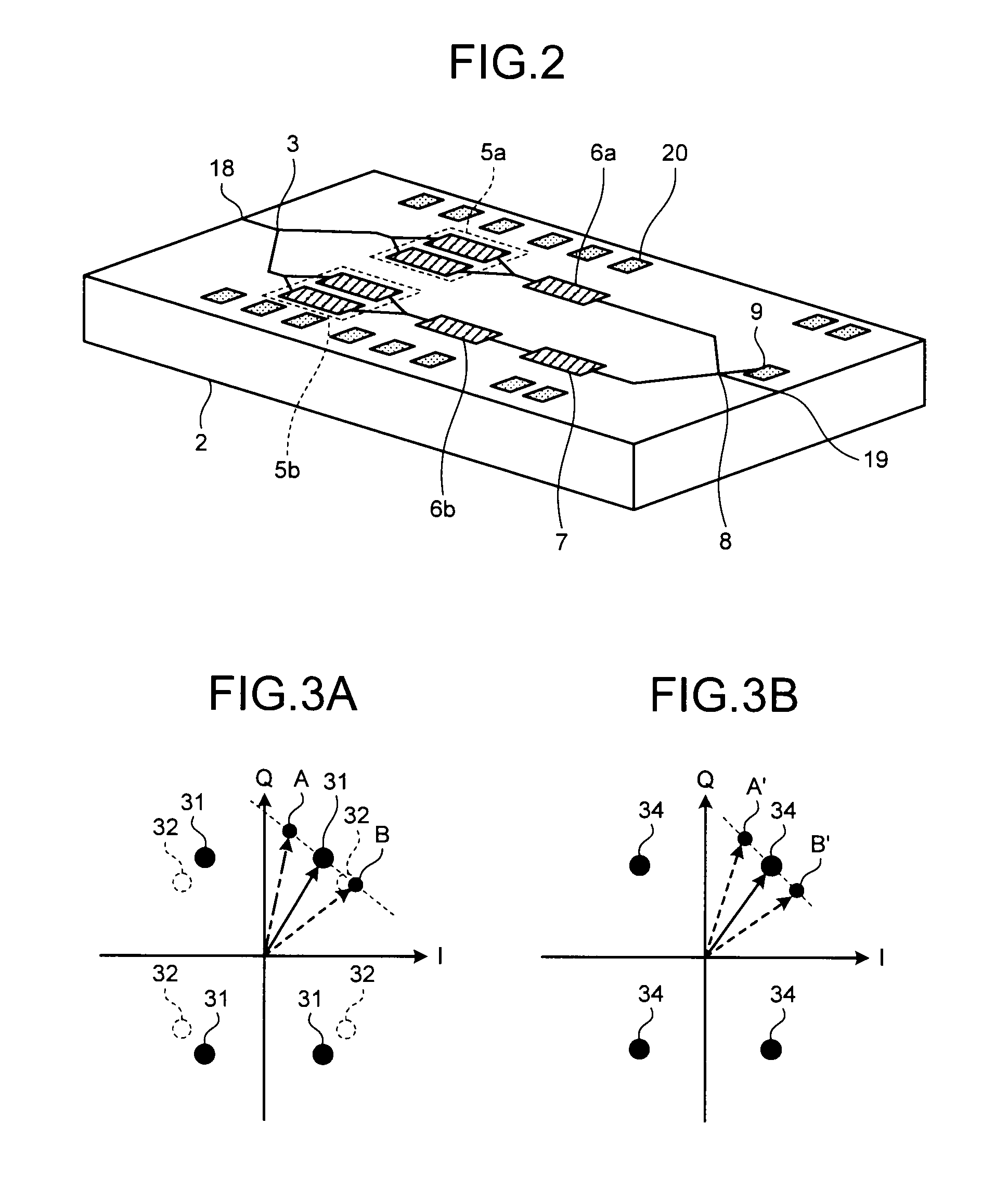Optical modulator, optical transmission device, and bias adjusting method
a technology of optical transmission device and optical modulator, which is applied in the direction of optical elements, optical waveguide light guides, instruments, etc., can solve the problems of large variation of loss, increased loss in optical modulator, and larger loss in sub-modulator
- Summary
- Abstract
- Description
- Claims
- Application Information
AI Technical Summary
Benefits of technology
Problems solved by technology
Method used
Image
Examples
first embodiment
[0026]FIG. 2 is a schematic diagram of an example of the optical modulating unit 2 mounted on a substrate. In FIG. 2, constituent elements denoted by like reference numerals as those in FIG. 1 have functions identical to those in FIG. 1. The mounted optical modulating unit 2 shown in FIG. 2 includes electric terminals 20 to connect the optical modulating unit 2 with external electric signals, optical input waveguides 18 to input optical signals from outside, and an optical output waveguide 19 to output optical signals to outside, in addition to the constituent elements shown in FIG. 1. The optical input waveguides 18 are connected to the optical demultiplexing unit 3, and output light is input from the light source 1 to the optical demultiplexing unit 3. The optical output waveguide 19 is connected to the optical multiplexer 8, and outputs optical signals that are input from the optical multiplexer 8 to outside. The schematic diagram of FIG. 2 is an implementation example, actual s...
second embodiment
[0064]In the second embodiment, an amplitude of a superimposed low-frequency pulse signal is adjusted based on a characteristic (for example, a characteristic shown in FIG. 6A) of an amplification factor to a bias current input to the first optical amplifier 6a and the second optical amplifier 6b, respectively. Therefore, an adjustment error attributable to a change rate of an amplification factor of a bias signal input to the first optical amplifier 6a and a change rate of an amplification factor of a bias signal input to the second optical amplifier 6b as described above is prevented.
[0065]FIG. 6B is an example of a low-frequency pulse signal superimposed on the first optical amplifier 6a and the second optical amplifier 6b according to the second embodiment. When complementary low-frequency pulse signals are generated, the second DC bias corrector 17 generates low-frequency pulse signals such that the ratio of an amplitude “a” of a low-frequency pulse signal (a low-frequency puls...
third embodiment
[0072]In the third embodiment, two kinds of bias signals for a first optical amplifier 25a and a second optical amplifier 25b are input from the fourth DC bias controller 14 to the first optical amplifier 25a and the second optical amplifier 25b, respectively. Similarly, two kinds of bias signals for a third optical amplifier 25c and a fourth optical amplifier 25d are input from the fifth DC bias controller 15 to the third optical amplifier 25c and the fourth optical amplifier 25d, respectively. The fourth DC bias controller 14 can be configured to include a functional unit that generates a bias signal for the first optical amplifier 25a, and a functional unit that generates a bias signal for the second optical amplifier 25b. Similarly, the fifth DC bias controller 15 can be configured to include a functional unit that generates a bias signal for the third optical amplifier 25c, and a functional unit that generates a bias signal for the fourth optical amplifier 25d.
[0073]An optical...
PUM
| Property | Measurement | Unit |
|---|---|---|
| phase | aaaaa | aaaaa |
| frequency | aaaaa | aaaaa |
| strength | aaaaa | aaaaa |
Abstract
Description
Claims
Application Information
 Login to View More
Login to View More - R&D
- Intellectual Property
- Life Sciences
- Materials
- Tech Scout
- Unparalleled Data Quality
- Higher Quality Content
- 60% Fewer Hallucinations
Browse by: Latest US Patents, China's latest patents, Technical Efficacy Thesaurus, Application Domain, Technology Topic, Popular Technical Reports.
© 2025 PatSnap. All rights reserved.Legal|Privacy policy|Modern Slavery Act Transparency Statement|Sitemap|About US| Contact US: help@patsnap.com



